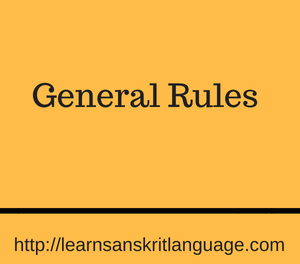Introduction:
The perfect tense uses both the strong and weak tense, therefore, the constructions of these stems are even more difficult.
Extra Rules for reduplication.
ṛ, ṝ, and ḷ will change to a.
तॄ → ततॄ
tṝ → tatṝ
कॢप् → चकॢप्
kḷp → cakḷp
कृ → चकृ
kṛ → cakṛ
Roots starting with a and ā use a for reduplication with merges with root to form ā.
आप् → आप्
āp → āp
अद् → आद्
ad → ād
Roots starting with i- use i for the reduplication. Which then merges with the root to form ī. Exception: If the i- is strengthened, it would form iy.
इ + एष् → इयेष्
i + eṣ → iyeṣ
इ + इष् → ईष्
i + iṣ → īṣ
Roots which make use of saṃprasāraṇa roots: roots beginning with va use u and the ones beginning with ya use i.
यज् → इयज्
yaj → iyaj
वच् → उवच्
vac → uvac
Endings for the strong stem.
Roots that end with vowels.
The final vowel sound is based on the person:
1st person: medium or strong
2nd person: medium
3rd person: strong.
Look at the examples given below.
कृ → चकृ → चकर
kṛ → cakṛ → cakar
do → did → You did.
कृ → चकृ → चकार, चकर
kṛ → cakṛ → cakāra, cakara
do → did → I did.
कृ → चकृ → चकार
kṛ → cakṛ → cakāra
do → did → He did.
However, some of the words do not end in this manner. Roots which end in ā, e, ai or o change into au. Few examples given below are:
धा → दधा → दधौ
dhā → dadhā → dadhau
गै → जगै → जगौ
gai → jagai → jagau
One exception to this is root hva, it appears as hve. This root is treated the same way hu is, and gets strengthened in the same way as kr.
Roots ending in consonants.
Roots are mostly strengthened to “guna”. Look at the examples given below.
इष् → इयेष्
Ish-iyesh.
जीव् → जिजीव्
jīv → jijīv
बुध् → बुबोध्
budh → bubodh
Some roots cannot be strengthened to GUNA, some vowels will never undergo the change of guna. Such a root has two qualities:
If we remove the last consonant, the result is a heavily accentuated syllable.
The root ends in a consonant.
When both these factors are present, the guna rule does not apply.
For those roots in which a is followed by one consonant, a becomes ā.
Weak stem.
Weak stem refers to the one in which following vowels occur word finally.
i, ī, u, ū, ṝ
The final vowel of the root is going to undergo the following changes.
Final u and ū become uv, and final ṝ becomes ar, in all circumstances.
If it follows just one consonant: final i and ī turn into y, and final ṛ changes to r.
If it follows more than one consonant: final i and ī become iy, and final ṛ becomes ar.
Contraction.
In some cases, a single syllable will be formed by reduplication, for such a root, all the following is true.
The reduplication commences with the same consonant as the root.
Root has two consonants: one before the vowel, one afterward.
The root vowel is a.
The root vowel gets transferred from a to e.
Except for five verb roots, jan, khan, gham, khaas, han, the stem is usually weakened by removing the vowel.
जगम् + ए → जग्मे
jagam → jagme
जघस् + ए → जक्षे
jaghas → jakṣe
जघन् + ए → जघ्ने
jaghan → jaghne
जगन् + ए → जज्ञे
jagan → jajñe
जखन् + ए → जख्ने
jakhan → jakhne
samprasarana.
These roots take the samprasarana : vac, vad, vap, vas, svap , yaj, vyadh, grah.
Look at the examples given below:
वव्यध् + ए → वविधे
vavyadh + e → vividhe
जग्रह् + ए → जगृहे
jagrah + e → jagṛhe
उवच् + ए → ऊचे
uvac + e → ūce
इयज् + ए → ईजे
iyaj + e → īje





